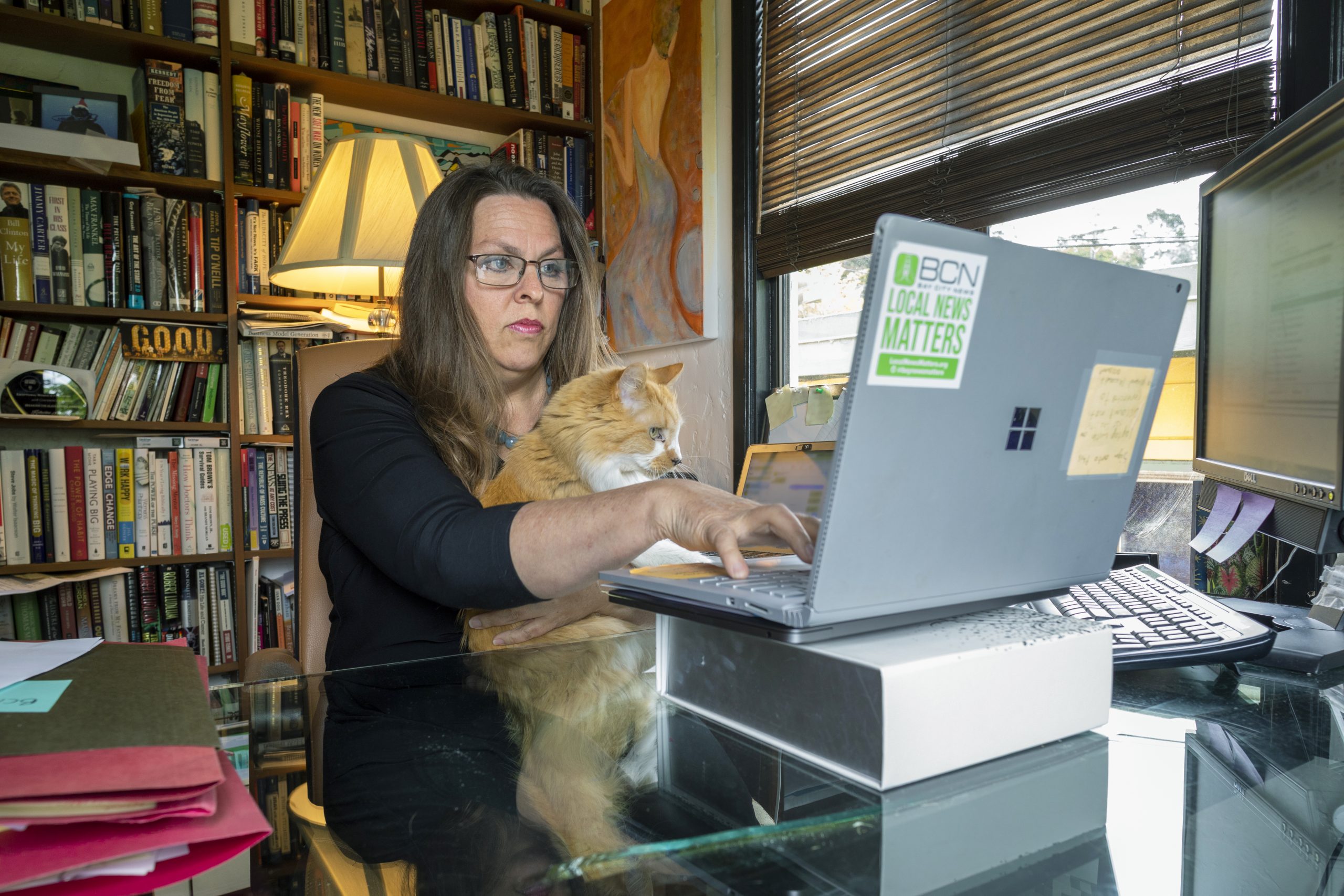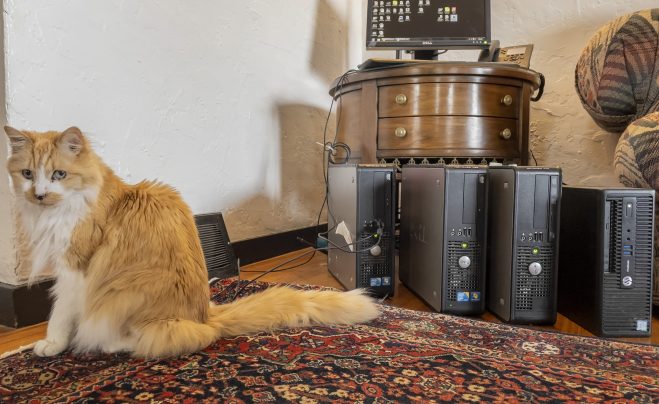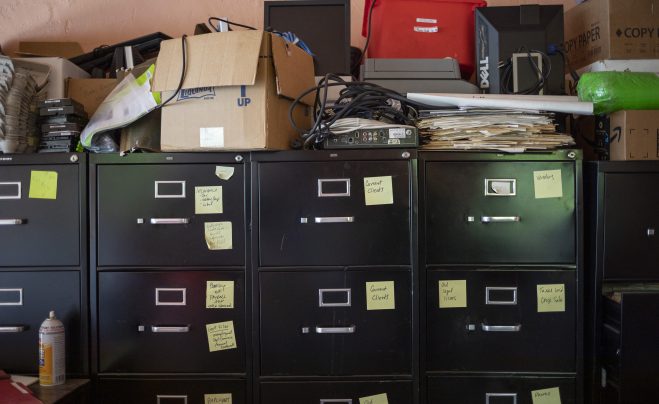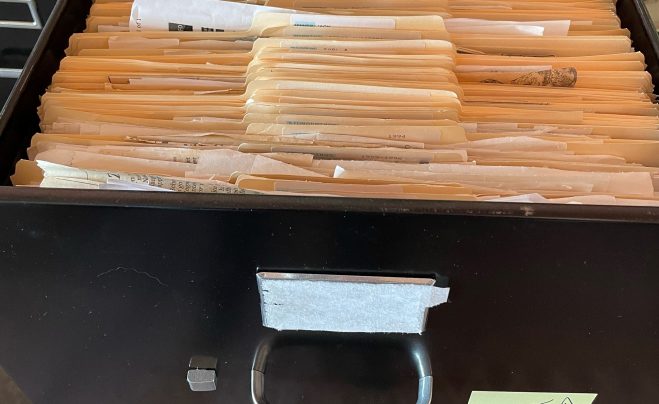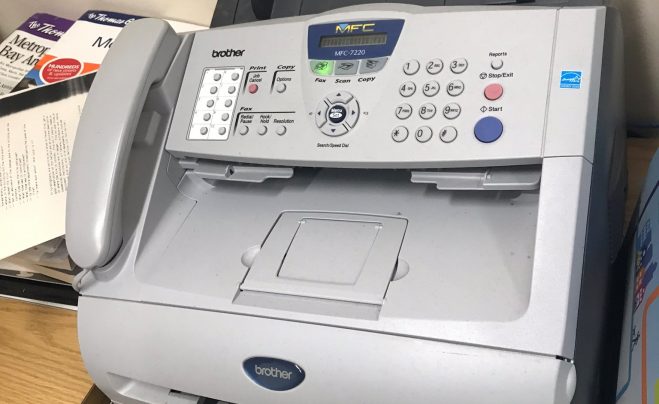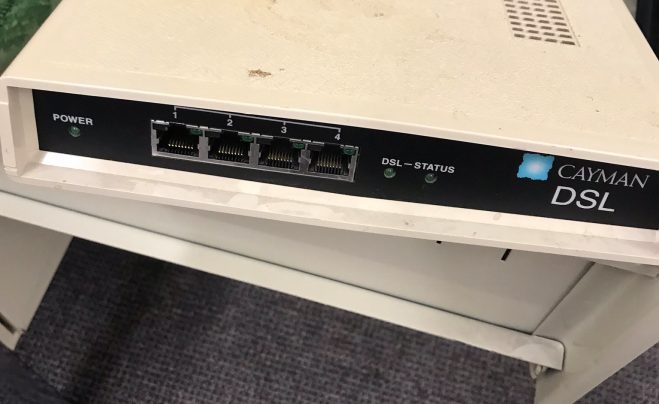Katherine Ann “Kat” Rowlands was an eager summer intern for Bay City News Service 35 years ago when, even as a cub reporter shadowing veteran journalists, she remembers thinking, “I bet I could run this place.”
That refrain lingered through the ensuing decades of her career as a journalist — from a reporter and editor in the San Francisco Bay Area to a foreign correspondent in the Netherlands and Honduras — until finally, in March 2018, she walked into the newswire’s Oakland, California, headquarters as its newly minted publisher and sole owner.
Rowlands knew it would be daunting to take over a news organization amid an industry-wide crisis. Declining revenue has forced more than 2,100 newspapers to shut down in the U.S. over the past 15 years as advertisers and subscribers moved to free online options. But the challenge grew as she surveyed the Bay City News newsroom that first day, with its garage-sale atmosphere of decrepit desktop computers, dusty pagers, broken fax machines and cabinets full of yellowing paper files.

“There are a lot of small newsrooms just like this, limping along with very old technology and making it work because they have to, but with no capital resources or IT team to help,” Rowlands says. “They’re focused on the journalism and not the backend of the operation. As part of my entrepreneurial journey, I had to figure out how to do all the business-side stuff in addition to journalism.”
But Rowlands is known for her ingenuity and her exhaustive network, and before long Bay City News was a bright green dot on a map turning brown from so-called news deserts creeping over vast swaths of the country. In just three years — and during a global pandemic that forced dozens more news organizations to shutter — she has boosted the number of counties her newswire covers around San Francisco, added reporters, hired the company’s first photo editor and won multiple awards. She also created a nonprofit foundation with a local news website that reaches out directly to the region’s 8 million residents, and she gave the whole group a tech makeover.
“We’re trending in the opposite direction of a lot of local news organizations, so that’s exciting,” says Kiley Russell, who’s been a reporter since 1995 and is coming up on his fifth year with Bay City News. “Kat has been a godsend for my career.”
Rowlands, 55, was born and raised in Berkeley, in the pink house she now owns that has become Bay City News headquarters during the pandemic. Her parents had subscribed to three daily newspapers and dozens of magazines and watched TV news every night, so Rowlands grew up steeped in awareness of civic life and the importance of having solid information to participate in it.
She worked on her high school and college newspapers and spent her summers at Bay City News, covering for reporters’ vacations and gaining experience with just about every role, bureau and shift at the news agency.
Since 1979, Bay City News has provided a steady stream of articles and a daily events calendar to newspapers and broadcasters in the San Francisco Bay Area, as well as to government agencies and public-relations firms — anyone who needs to keep tabs on the region. Media subscribers republish the stories in their own publications or use them as background for their own pieces or as ideas for assignment editors.
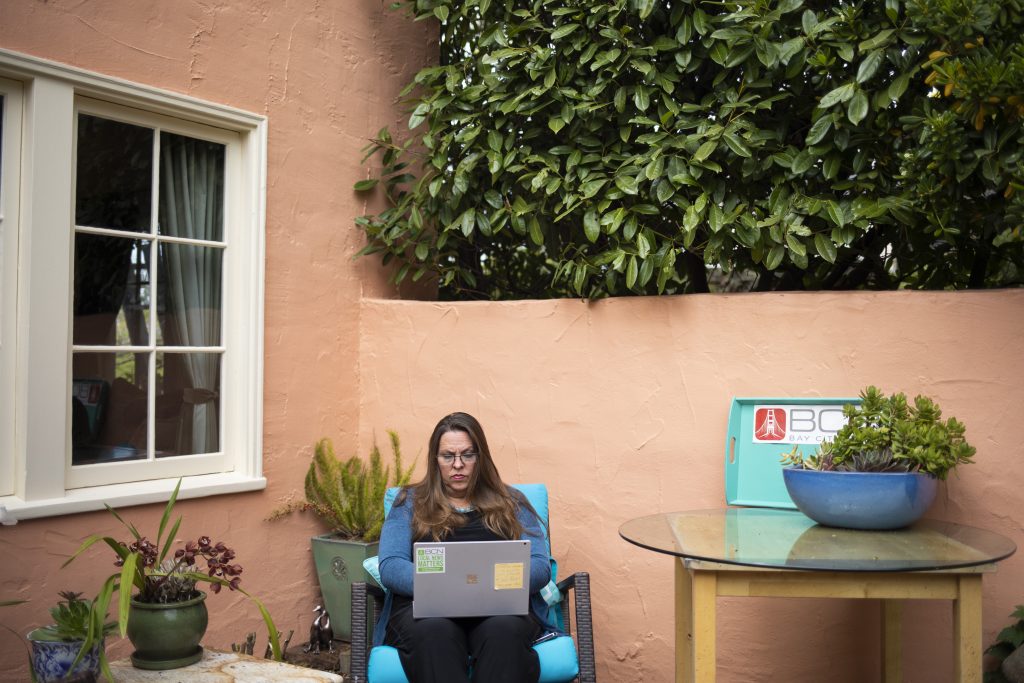
Rowlands learned that Bay City News was coming up for sale when she was halfway through a yearlong John S. Knight Journalism Fellowship at Stanford University in 2017. She had been researching newsroom gender disparities for her fellowship project, and she found that it all came down to hiring choices.
“It’s a simple solution to get that disparity corrected,” Rowlands says.
Buying Bay City News would put her in charge of those hiring choices, at least for one news organization.
Rowlands began taking business and entrepreneurial classes at Stanford, studying media business models, hiring and recruiting processes and more. And in March 2018, she bought all the shares of the company.
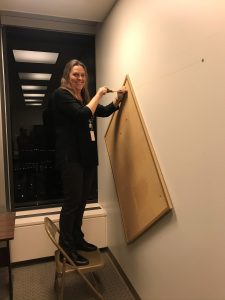
The biggest thing Rowlands is known for in media circles is knowing everyone in media circles, and she relied on those contacts for guidance as she contemplated how Bay City News could grow in a shrinking landscape. She also created a Wise Women Council to make sure the advisory board wasn’t dominated by men, as most are.
Rowlands settled on a hybrid business model, pairing the established, for-profit wire service and its large-scale subscribers with a new nonprofit site reaching out directly to readers. The site, LocalNewsMatters.org, has a public-service mandate to provide Bay Area residents with free, community-oriented news stories funded by philanthropic donations, which amounted to $450,000 in 2021.
The wire sends out about 40 stories a day covering civic matters such as court cases, public officials, weather, accidents and crime, along with a popular datebook calendar of verified events around the region. The multimedia website fills in the gaps with stories focused on equity, health, volunteerism, arts and culture. About 20 reporters and editors work on each side of the business, along with paid interns, several of whom now have been hired full-time at Bay City News.
It’s a model worth emulating, says Sue Cross, executive director and CEO of The Institute for Nonprofit News (INN), which was formed in 2009 and now provides support for 310 nonprofit news organizations.
“When you put a civic purpose as the mission rather than generating profit, it profoundly shapes the kind of news these newsrooms produce,” Cross says. “Going to a four-hour city council meeting might be tremendously important for civic life but incredibly expensive for a news organization.”
There’s now a much lower barrier of entry for news outlets, which can start with a newsletter or website and no longer need a printing press or broadcast license, Cross says.
“But regardless,” she says, “technology is absolutely critical to reaching your audience.”
And that technological hurdle — more than the staffing, the precarious finances, the journalism — was what worried Rowlands the most.
Since she had already depleted her savings, maxed out her credit cards and gotten loans from family and friends to buy Bay City News, Rowlands had to get creative for the “radical transformation” she knew was needed.
Microsoft President Brad Smith had put journalism high on his list of the top 10 tech policy issues — seeing it as key to preserving democracy — so Rowlands reached out to the company for help. By January 2020, her reporters were working on new, loaned laptops with Microsoft 365 software licenses donated by the tech company. The timing was prescient, as COVID-19 swept the region just three months later.
Bay City News was already set up as a remote system, with headquarters in Oakland and eight bureaus around the region. But the DSL line reporters used to send stories to the main office for editing only provided a one-way transfer; simultaneous editing or back-and-forth weren’t possible. Everyone had a different means of communicating with calls, texts, emails and video conferencing, all happening on different platforms.

Now, reporters not only communicate on Microsoft Teams, that’s also how they file their stories for editing — a smoother process than the cut-and-paste or attach-document email methods that had always resulted in “weird formatting issues” and took up precious time when news was breaking, Russell says. Despite the lack of a central office during the pandemic, the collaboration that was made possible with tech tools helped the small organization win nine awards from the San Francisco Press Club, from breaking news to enterprise feature stories and investigative work.
“Nothing beats the bullpen of an actual newsroom in person, but Teams approximates it as much as one can” by providing a platform for spontaneous conversations that are often key to story ideas, Russell says.
For someone with an “old-school” newspaper and wire service background, the past year proved a steep learning curve, Russell says. But Rowlands made sure training came along with the new tools, from Microsoft’s Data Journalism and Microsoft 365 for Journalists programs along with Microsoft partners such as Enlighten, FSI Strategies and Sue Hanley LLC.
Until last year, Russell’s experience with data reporting had been limited to Excel spreadsheets. Then he learned how to use Power BI, Microsoft’s data visualization software. He’d soon downloaded “loads of records” from the California Department of Water Resources, which manages a complex web of thousands of municipal and privately owned water systems. He organized it all to find the overarching patterns and illustrative anecdotes that made for a compelling story about the health of the Bay Area’s water supply.
Then he created an interactive graphic that allowed readers to find their own drinking water systems and see what contaminants or violations had been found, as well as how their water compared to others’ around the state.
“Now we’re constantly working to find data sources that we can bring to the Power BI platform to help illustrate stories we’ve written or are writing,” Russell says. “It’s lending itself to more robust and in-depth reporting.”
Case in point: The organization won an award from LION Publishers this year for its COVID-19 Information Hub, which included consumer resources, photos, stories and data graphics built with Power BI. Judges said the portal provided “a wonderful public service” for those who wanted to dig into data as well as those who just wanted a quick snapshot.
When the pandemic began, all the Bay City News servers ended up in the middle of Rowlands’ living room, with the entire operation running over her personal internet line. Since it’s a 24/7 news service and stories are sent over the wire at least once every hour, she was tethered to her home for much of the year so she could reboot the server whenever there was a glitch, whether it meant getting out of bed at 2 a.m. or cutting a neighborhood stroll short.
A customized Power Apps interface finally made it possible to tap into the newswire’s distribution system from anywhere, meaning colleagues could share the load during their shifts — and Rowlands could finally sleep through the night and even go on a three-hour hike in the hills above the bay.
On Election Night in November, Bay City News’ operations shifted to the cloud, opening up new possibilities for growth as editors could suddenly file stories from anywhere and eventually attach photos and graphics to them. Rowlands hired the newswire’s first photo editor and expanded coverage by three more counties in the region, to 12. And now the organization is set to begin distributing stories through Microsoft Start, the service that provides a personalized news feed with content from publishers around the world.
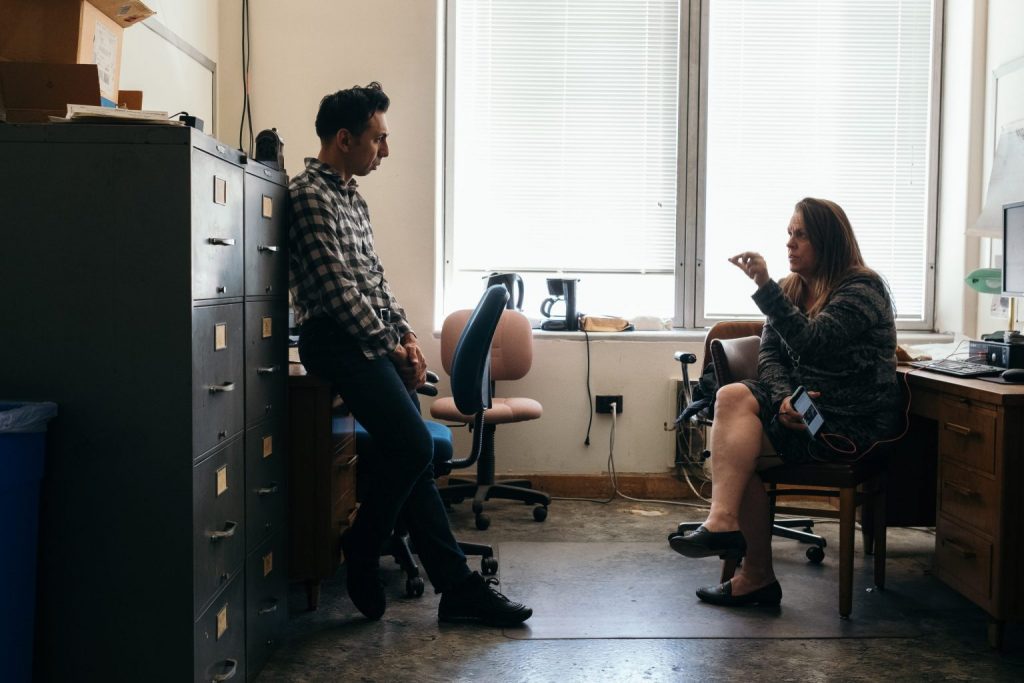
“Even though news organizations have been struggling, there is still a voracious demand for information,” she says. “The more we’re able to grow, the better we are at cementing our position as the backbone of the media ecosystem in this region. And now we’ve moved from a place of deep technology debt to a place where we’re set up to do all kinds of really creative work.”
Her efforts are being lauded within the industry, as it seeks survival while struggling to tell its own story.
“There’s a core need in a democratic society to have fact-based information,” says Joaquin Alvarado, a consultant for media companies such as The Seattle Times and an advisor for Microsoft’s Protecting Journalism program. “But most consumers and readers don’t know how local news happens. The critical coverage news organizations like Bay City News provide might feel mundane, until it’s gone.”
Thousands of communities have lost their local newspapers, and the lack of oversight has increased costs for local governments, research shows — a burden born by taxpayers.
So those who are innovating to keep reporters at work are “heroes of the local journalism movement,” Alvarado says. “Kat is the exact kind of person we need leading in this space. We need people like her who are committed enough, stubborn enough, courageous enough to take on these legacies and transform them before they go dark.”
Lead image: Kat Rowlands and her cat Herman in her home office in Berkeley, California (Photo by John Brecher)
This story was originally published May 6, 2021, and was updated Dec. 20, 2021.

